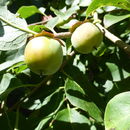More info for the terms:
shrubs,
swamp,
treeCommon persimmon grows on a wide variety of sites but grows best on
terraces of large streams and river bottoms. It grows best on alluvial
soils such as clays and heavy loams. In the Mississippi Delta, usual
sites are wet flats, shallow sloughs, and swamp margins. In the Midwest
it grows on poorly drained upland sites, but growth there is very slow
[
6,
17,
20,
23].
Common overstory associates not listed under Distribution and Occurrence
include eastern redcedar (Juniperus virginiana), sugar maple (Acer
saccharum), yellow-poplar (Liriodendron tulipifera),, boxelder (Acer
negundo), red maple (A. rubrum), sycamore (Platanus occidentalis), and
cedar elm (Ulmus crassifolia). Common shrubs and noncommercial tree
associates include swamp-privet (Forestiera acuminata), rough-leaf
dogwood (Cornus drummondii), hawthorns (Crataegus spp.), water-elm
(Planera acquatica), shining sumac (Rhus copallina), and smooth sumac
(R. glabra) [
6,
15,
26].

